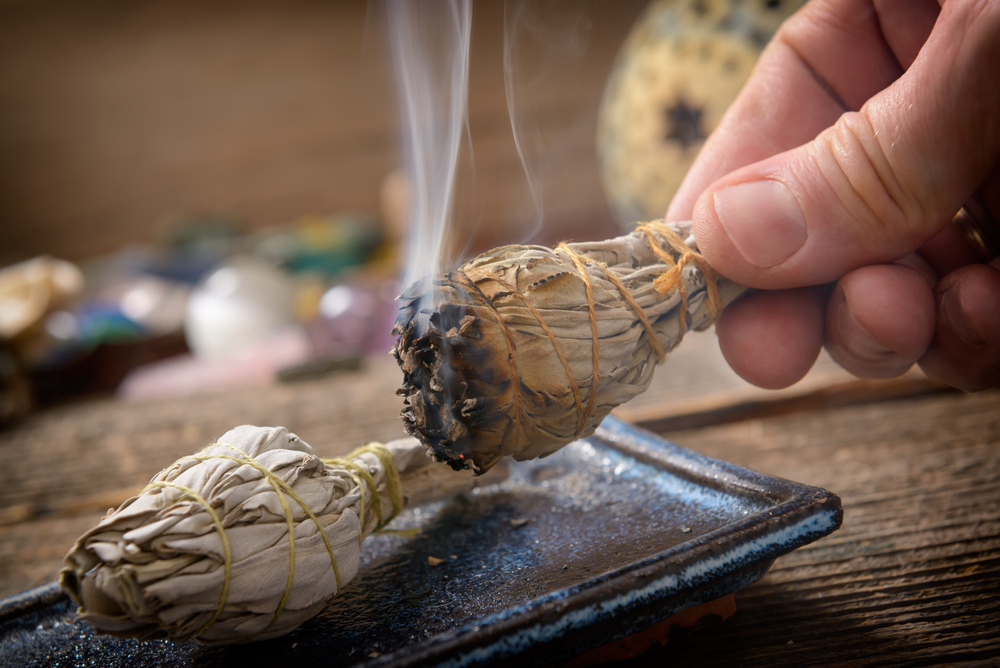That bundle of dried herbs or sacred wood you’ve seen people burning isn’t just about pleasant aromas or spiritual vibes. Across continents and throughout human history, sacred smoke has served as a powerful tool for maintaining physical health and energetic balance in ways that modern science is only beginning to understand and appreciate.
From white sage in Native American ceremonies to palo santo in South American traditions, from frankincense in the Middle East to sandalwood in Asian practices, humans have intuitively turned to smoke as medicine. These weren’t just symbolic gestures but practical health interventions woven seamlessly into cultural fabric.
The forgotten power of cleansing spaces
The most universal use of sacred smoke across cultures involves purifying living spaces. Long before we understood microbes or air quality, traditional healers used smoke to transform the energy and healthfulness of their environments.
Modern research has begun validating this ancient wisdom, showing that many traditional smudging plants possess antimicrobial properties. The smoke from white sage, for instance, has been found to reduce airborne bacteria by over 90% in some studies. The plants selected by traditional healers weren’t chosen randomly – they were identified over generations for their specific protective qualities.
But the purification goes beyond just killing germs. The smoke from certain plants releases negative ions, which can attach to positively charged particles like dust, mold spores, pet dander, and even viruses. This can help these particles settle out of the air, potentially improving air quality in a very physical way.
Many people report that spaces feel “lighter” or “clearer” after smoke cleansing. While this might seem purely subjective, these sensations could reflect actual changes in the air composition and the reduction of irritants that subtly affect our breathing and nervous system response.
The human energy field that responds to smoke
Traditional healing systems worldwide recognize what might be called the human energy body – a field of energy that surrounds and interpenetrates our physical form. In different traditions, it’s called prana, chi, aura, or biofield, but the concept appears consistently across unrelated cultures.
Sacred smoke is believed to interact directly with this energy field, helping to clear stagnant or negative energy and restore balance. If you’ve ever felt inexplicably drained in certain environments or around certain people, traditional healers would say you’re experiencing disruption in your energy field.
The smoke from specific plants appears to help “reset” this field, much like rebooting a computer that’s running sluggishly. People often report feeling lighter, more clear-headed, and energetically refreshed after being around sacred smoke.
The mechanism for this effect likely involves both the aromatic compounds released by the plants and the ionizing effect of smoke particles. Certain plant chemicals interact with our olfactory system and limbic brain in ways that directly affect our nervous system, potentially helping to shift energetic patterns that manifest as tension, anxiety, or emotional heaviness.
Plant allies with specific healing properties
Different smoking herbs offer distinct therapeutic benefits, something traditional healers have mapped through generations of careful observation. These aren’t vague spiritual claims but specific healing relationships between human physiology and plant compounds.
White sage, perhaps the best-known smudging herb in North America, contains compounds that are antimicrobial, anti-inflammatory, and calming to the nervous system. Its strong, sharp aroma helps clear mental fog and promote alertness while simultaneously reducing anxiety – a combination particularly valued for meditation or focused ritual work.
Sweetgrass, another sacred plant in many Native American traditions, contains coumarin, which gives it a sweet, vanilla-like scent. This compound has been shown to help regulate mood and may have mild sedative effects, explaining why sweetgrass smoke has traditionally been used to promote peace, comfort, and emotional openness.
Cedar, with its rich, warm scent, contains chemical compounds that stimulate the production of endorphins – your body’s natural feel-good hormones. Cedar smoke has traditionally been used for grounding and protection, creating a sense of security that allows for deeper healing work.
Palo santo, from Central and South America, contains limonene, a compound shown to reduce anxiety and stress while potentially boosting immune function. Its bright, citrusy aroma with hints of mint creates an energetically uplifting effect that traditional healers use to clear heavy emotions like grief or depression.
The smoke-brain connection science is discovering
The link between sacred smoke and mental wellbeing isn’t just traditional wisdom – it’s increasingly backed by neurological research. When we inhale the complex compounds in sacred smoke, they interact with our brains in measurable ways.
Many traditional smudging plants contain compounds that affect the limbic system – the emotional center of our brain. These compounds can trigger the release of neurotransmitters like serotonin and dopamine, directly influencing our mood and stress response.
The olfactory system, which processes scent, has direct pathways to the amygdala and hippocampus – brain regions involved in emotional processing and memory. This explains why smoke aromatics can trigger immediate emotional responses and why certain scents might evoke powerful memories or feelings.
Beyond the chemical compounds, the rhythmic, meditative practice of creating and using sacred smoke activates the parasympathetic nervous system – our rest-and-digest mode that counteracts stress and promotes healing. The simple act of slowing down, focusing on intention, and engaging in the rhythmic movement of smoke cleansing can shift our brainwave patterns toward more coherent, healing states.
Respiratory healing through strategic inhalation
While smoking tobacco or other substances directly into the lungs can be harmful, the controlled, indirect exposure to medicinal plant smoke used in traditional ceremonies appears to offer respiratory benefits for many conditions.
In numerous traditions, people with respiratory ailments would sit near – not directly in – the smoke of specific medicinal plants. Eucalyptus, for instance, contains eucalyptol, a powerful compound that helps open airways, reduce inflammation, and fight respiratory infections. The controlled exposure to this smoke could deliver these compounds to irritated respiratory tissues.
Cedar smoke contains compounds that act as expectorants, helping to clear mucus from the lungs and airways. Traditional healers often used cedar smoke treatments for people suffering from congestion, coughs, or bronchial infections.
Even frankincense, used in religious ceremonies across multiple faiths, contains boswellic acids that have significant anti-inflammatory properties, potentially benefiting those with asthma or other inflammatory respiratory conditions. The traditional use of frankincense in religious settings wasn’t just symbolic – it likely created healthier air for worship.
It’s worth noting that these benefits come from respectful, intentional use with proper ventilation – not from excessive exposure that could irritate the lungs. Traditional healers understood the difference between medicine and toxicity, using sacred smoke with precision rather than excess.
The ritual aspect that amplifies healing potential
The healing power of sacred smoke extends beyond just the chemical properties of the plants being burned. The ritual context – the how, when, and why of use – plays a crucial role in its effectiveness.
When sacred smoke is used with intention and respect, it creates a psychological state that enhances its physiological effects. This mind-body connection has been recognized by traditional healers but dismissed by conventional medicine until relatively recently.
We now know that belief and expectation can significantly influence healing outcomes – the well-documented placebo effect that mediates everything from pain perception to immune function. By approaching sacred smoke with reverence and clear intention, we potentially amplify its biochemical effects through our own mental engagement.
The ritualistic nature of smoke cleansing also helps create clear boundaries between different states or activities. Using sacred smoke to mark transitions – like beginning a healing session, entering a sacred space, or starting a new day – helps our brains and bodies shift gears more effectively. This cognitive reset can reduce stress and increase present-moment awareness, both of which support healing and balance.
Energetic protection in an overwhelming world
One traditional use of sacred smoke that holds particular relevance in our modern context is energetic protection. Traditional healers worldwide have used smoke to create boundaries against negative or chaotic energies – something many people intuitively seek in today’s overwhelming world.
In an era of constant digital connectivity, information overload, and high stress, many people report feeling energetically drained or invaded. The traditional practice of using protective smoke around the body and living spaces may offer a tangible way to establish energetic boundaries.
Plants traditionally used for protection, like rosemary, juniper, and dragon’s blood resin, contain compounds that stimulate and energize the nervous system while promoting mental clarity. This combination helps strengthen our natural energetic boundaries, making us less susceptible to being affected by external stressors or emotional contagion from others.
Many empathic or highly sensitive people find that regular use of protective smoke helps them maintain their emotional equilibrium in challenging environments. While the mechanism might be explained through aromatherapy’s effects on the nervous system, the subjective experience aligns perfectly with traditional understandings of energetic protection.
Smoke as a messenger between realms
Across diverse spiritual traditions, smoke is seen as a bridge between physical and non-physical realms – a messenger carrying prayers, intentions, or communications upward while bringing guidance or healing down. This metaphysical aspect might seem removed from health considerations, but it addresses a dimension of wellness many feel is missing from modern healthcare.
The visible rising and dissolving of smoke creates a powerful visual metaphor for transformation. When used in healing work, this symbolism can help people release emotional burdens, traumatic memories, or limiting beliefs that contribute to physical or energetic imbalance.
Many traditional healing systems view illness as having spiritual or energetic components that must be addressed alongside physical interventions. The use of sacred smoke helps engage these non-physical dimensions, creating a more holistic healing approach.
Even for those who approach such practices from a psychological rather than spiritual perspective, the act of symbolically releasing difficulties through smoke can create powerful cognitive shifts. These mental and emotional changes can directly impact physical health through the well-established pathways of psychoneuroimmunology – the science of how our thoughts and feelings influence our nervous and immune systems.
Incorporating sacred smoke with respect and awareness
The growing popularity of practices like smudging has raised important questions about cultural respect, sustainability, and proper usage. Approaching sacred smoke with awareness of these considerations helps preserve both the traditions and the plants themselves.
Many traditional smudging plants like white sage have faced overharvesting as their popularity grows. Choosing ethically harvested, sustainably grown plants – or growing your own – helps ensure these practices can continue. Some traditions encourage giving back when harvesting – leaving an offering of tobacco, corn meal, or prayers in exchange for taking the plant.
Learning about the specific cultural contexts of different smoke traditions helps maintain respect for their origins. White sage and sweetgrass hold particular sacred importance for many Native American tribes, while palo santo has deep significance in Amazonian and Andean traditions. Acknowledging these roots and learning from traditional knowledge keeps the practices connected to their wisdom.
The effectiveness of sacred smoke doesn’t require appropriating specific cultural ceremonies. The fundamental practice of using plant smoke for purification and healing appears across human cultures precisely because it works on basic principles of plant medicine and energy. Finding an approach that resonates with your own heritage or developing a personal practice based on universal principles can be both effective and respectful.
Whether you approach sacred smoke as spiritual practice, energy medicine, aromatherapy, or simply a mindful ritual, its potential benefits for health and balance have stood the test of time. In our modern world of synthetic environments and digital overload, reconnecting with this ancient practice might offer exactly the kind of grounding, cleansing, and rebalancing our bodies and energy fields are seeking.
















